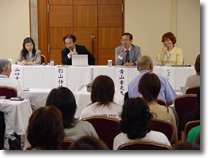| Date: |
Sunday 11th
July 2004, 13:00-16:00 |
| Venue: |
Portopia
Hotel, eBanquet Room NUNOBIKI,KITANOf(Main Building B1F)
|
| Organizer: |
NPO Knots |
| Special Sponsor: |
Nestle Purina PetCare |
| Sponsor: |
Asahi Breweries,
Ltd., Kawai Acoustic System Co.,Ltd |
| Cooperation: |
Tsutomu
Nakauchi Foundation |
| Supporting Organizations: |
Hyogo Prefecture, Kobe
City, Hyogo Prefecture Board of Education,
Kobe City Board of Education,
Japan Veterinary Medical Association,
Veterinary Association of Hyogo Prefecture,
Veterinary Association
of Kobe City,
Japan Society for the Prevention of Cruelty to Animals,
JSPCA,
JAPANESE SOCIETY OF HUMANE CARE OF ANIMALS,
Japan Animal
Welfare Society,
Japan Pet Care Association,
Japanese Animal Hospital
Association (JAHA),
Osaka Kobe Consulate General of the USA, Kansai
American Center. |
| Chairperson: |
Ms.
YAMAZAKI Keiko, Companion Animal Study Group gGoh |
| Speaker: |
Keynote
Speech
Dr.
Joan Dalton@(USA), Executive director, Project POOCH, Inc.
eDog Training at Reformatoriesf
Report about eProject Poochf the rehabilitation program that uses rescued dogs
from shelters. The positive results for both the dogs and youths have been excellent.
|
| |
Panel Discussion
Panelists
@- Dr. Joan Dalton
@- Mr. AOYAMA Yukikatsu,
@@ Director of Nara Probation Office, Rehabilitation Bureau,
@@ Ministry of Justice
@- Dr. KAGEYAMA
Jinsuke, Professor of Neuro-Psychiatric Science,
@@ Tokyo Institute of Technology
@- Dr. YAMAGUCHI
Chizuko, Veterinary Inspector of Japan Animal
@@ Welfare Society |
|
On this occasion, we extended
a special invitation to Dr. Joan Dalton, Director of Project Pooch
Inc. to provide us with the keynote speech. Project Pooch is a rehabilitation
(correctional) program for juvenile criminals.
 @Under
the program, young people are assigned a dog (from a dog shelter)
and encouraged to assume responsibility for its care, training and
for finding it a new home. The process allows them to learn how to
be responsible and patient, how to show consideration for another
life, the feeling of being needed and many other forms of empathy
etc. Training is not based on the exertion of physical epowerf, but
utilizes the epositive enforcement methodf involving praise etc.
This method also teaches young people how to control their own behavior.
From their relationship with the dogs they also learn the practical
skills needed to become trimmers, discipline trainers, pet sitters,
etc. Results have shown that the young people who join the project
have a higher level of motivation and are better able to resolve
problems than those who do not. @Under
the program, young people are assigned a dog (from a dog shelter)
and encouraged to assume responsibility for its care, training and
for finding it a new home. The process allows them to learn how to
be responsible and patient, how to show consideration for another
life, the feeling of being needed and many other forms of empathy
etc. Training is not based on the exertion of physical epowerf, but
utilizes the epositive enforcement methodf involving praise etc.
This method also teaches young people how to control their own behavior.
From their relationship with the dogs they also learn the practical
skills needed to become trimmers, discipline trainers, pet sitters,
etc. Results have shown that the young people who join the project
have a higher level of motivation and are better able to resolve
problems than those who do not.
However, the greatest gain from the project has been the result,
to date, that there have been zero repeat offenders from among those
who took part, evidence of the extraordinary effectiveness of the
project.
The Symposium audience listened to Dr. Daltonfs lecture very attentively.
At the end of the lecture, a video was screened which told the story of
one youth who had graduated from Project Pooch. The story moved many people.
After the break, one of the panelists, Mr. Aoyama, Director of Nara
Probation Office reported the current situation within correctional
schools. Despite the fact that delinquency laws have been tightened
since 1999 offences have not decreased and correctional facilities
remain over-crowded. It is therefore extremely difficult to provide
satisfactory rehabilitation or educational guidance on an individual
basis to young offenders.
@
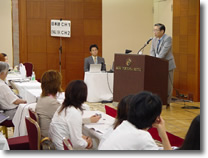 @Mr.
Aoyama said that he hoped the introduction of a Project Pooch-style
program in Japan might be a real opportunity to exert a positive
influence on juveniles and create a stir in the education at correctional
facilities. He also explained about Japanfs correctional probation
system which uses Volunteer Probation Officers, a system which is
unique to Japan. Correctional probation means that the state, in
cooperation with private citizens, helps people who have committed
crimes (and delinquents) to learn how to rehabilitate themselves
into society as early as possible. Ultimately, the aim is to prevent
crime and further delinquent behavior. Citizens who, as private volunteers,
tie up with probation officers in order to conduct corrective probation
activities are called Volunteer Probation Officers. There are 48,000
of them in Japan. This is a wonderful system unique to Japan. @Mr.
Aoyama said that he hoped the introduction of a Project Pooch-style
program in Japan might be a real opportunity to exert a positive
influence on juveniles and create a stir in the education at correctional
facilities. He also explained about Japanfs correctional probation
system which uses Volunteer Probation Officers, a system which is
unique to Japan. Correctional probation means that the state, in
cooperation with private citizens, helps people who have committed
crimes (and delinquents) to learn how to rehabilitate themselves
into society as early as possible. Ultimately, the aim is to prevent
crime and further delinquent behavior. Citizens who, as private volunteers,
tie up with probation officers in order to conduct corrective probation
activities are called Volunteer Probation Officers. There are 48,000
of them in Japan. This is a wonderful system unique to Japan.
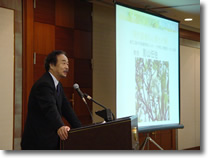 Next,
Professor Kageyama of Tokyo Institute of Technology, a specialist
in criminal psychology, introduced data about Japanfs murder rate
and violent crimes, such as assault and bodily harm, and compared
the data with statistics from the USA. In Japan, while overall crime
is on the decrease, the number of female teens committing crimes
has been increasing which is a shocking development. Another interesting
piece of data from America shows that children brought up by a single,
but loving, parent are less likely to go astray than those brought
up by two parents who do not get on. Dr. Kageyama also said that
early stage interference seems to be effective in preventing juvenile
delinquency and that correctional education programs suited to individual
cases prove more effective.@ Next,
Professor Kageyama of Tokyo Institute of Technology, a specialist
in criminal psychology, introduced data about Japanfs murder rate
and violent crimes, such as assault and bodily harm, and compared
the data with statistics from the USA. In Japan, while overall crime
is on the decrease, the number of female teens committing crimes
has been increasing which is a shocking development. Another interesting
piece of data from America shows that children brought up by a single,
but loving, parent are less likely to go astray than those brought
up by two parents who do not get on. Dr. Kageyama also said that
early stage interference seems to be effective in preventing juvenile
delinquency and that correctional education programs suited to individual
cases prove more effective.@
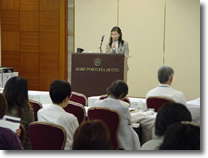 @Finally,
Dr. Yamaguchi from the Veterinary Inspector of Japan Animal Welfare
Society talked about how welfare for animals is the same
as welfare for humans, humans being just another kind of animal species.
In Project Pooch, by saving animals children themselves are saved
and, in the end, the happiness of the animals can have a wonderful
influence on children. In Japan people are very susceptible to trends
and willingly engage to create eboomf phenomena. Now there are many
therapies using animals, however, Dr. Yamaguchi insisted on the importance
of protecting the animalsf own happiness and said that, if the welfare
of the animals involved is not securely monitored, the excellent
results gained from such good programs as the Project Pooch project
would not be possible. @Finally,
Dr. Yamaguchi from the Veterinary Inspector of Japan Animal Welfare
Society talked about how welfare for animals is the same
as welfare for humans, humans being just another kind of animal species.
In Project Pooch, by saving animals children themselves are saved
and, in the end, the happiness of the animals can have a wonderful
influence on children. In Japan people are very susceptible to trends
and willingly engage to create eboomf phenomena. Now there are many
therapies using animals, however, Dr. Yamaguchi insisted on the importance
of protecting the animalsf own happiness and said that, if the welfare
of the animals involved is not securely monitored, the excellent
results gained from such good programs as the Project Pooch project
would not be possible.
@
 @
After the above speeches the chairperson, Ms. Yamazaki, moved on
to the panel discussion followed by a questions and answers time. @
After the above speeches the chairperson, Ms. Yamazaki, moved on
to the panel discussion followed by a questions and answers time.
Ms. Yamazaki said that if programs with such excellent results as Project Pooch
were introduced in Japan, it would be very important to ensure high standards
in the esoftwaref used, referring to the manpower involved with the projects.
A great deal of attention needs to be paid to the young offenders entering the
project, and also to the dogs to ensure their happiness and a high level of well
being. Ms. Yamazaki warned that unless there is a firm and stable policy exercised
by the staff concerned, and throughout management and training, the program could
end with a negative result.
As in the previous year, the Symposium enjoyed far more attendants than expected,
and the venue was full. In particular, many students came from distant prefectures.
The running time was extended. In recent times there have been several tragic
incidents involving young people. The Organizers sincerely hope that everyone
involved in this symposium, and all the adults attending, will give careful consideration,
and act where necessary, for the good of children and animals to prevent an increase
in the number of wrongdoers and victims. It was hoped that this symposium provided
such an opportunity.
|
 @ @
After
the Symposium, a small welcome party was held for Dr. Joan Dalton and the other
speakers. This event was open to anyone paying the entrance fee and guests were
able to talk to the Symposium speakers directly and exchange views among people
with similar interests. This time the guest count was 66 people.
Ms. Tominaga, the Knots Representative gave the opening speech followed
by a speech by Tim Wilson, the Marketing Manager of Nestle Purina PetCare
who promised to support the 2005 symposium, a commitment which is gratefully
acknowledged. Mr. Wilson proposed the toast and the party started.
Many people were soon involved in deep discussion, exchanging business
cards etc., and the atmosphere was cheerful throughout the room.
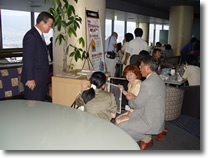 There was also a display of the eWonderroomf, a sound proof cage for
pets developed by Kawai Sound System Company, one of the companies
supporting the Symposium. Many people, including Dr. Dalton, inspected
the product and offered their opinions and advice. There was also a display of the eWonderroomf, a sound proof cage for
pets developed by Kawai Sound System Company, one of the companies
supporting the Symposium. Many people, including Dr. Dalton, inspected
the product and offered their opinions and advice.
This Symposium addressed the important and serious theme of crime
prevention and correctional education for youth offenders, and also
seeking possibilities for helping out unhappy animals. It was extremely
encouraging to know that so many people were interested in the issues
and thought about them seriously, and further more, the day of the
symposium made many more new eknotsf amongst people.
|

 @
@ @Under
the program, young people are assigned a dog (from a dog shelter)
and encouraged to assume responsibility for its care, training and
for finding it a new home. The process allows them to learn how to
be responsible and patient, how to show consideration for another
life, the feeling of being needed and many other forms of empathy
etc. Training is not based on the exertion of physical epowerf, but
utilizes the epositive enforcement methodf involving praise etc.
This method also teaches young people how to control their own behavior.
From their relationship with the dogs they also learn the practical
skills needed to become trimmers, discipline trainers, pet sitters,
etc. Results have shown that the young people who join the project
have a higher level of motivation and are better able to resolve
problems than those who do not.
@Under
the program, young people are assigned a dog (from a dog shelter)
and encouraged to assume responsibility for its care, training and
for finding it a new home. The process allows them to learn how to
be responsible and patient, how to show consideration for another
life, the feeling of being needed and many other forms of empathy
etc. Training is not based on the exertion of physical epowerf, but
utilizes the epositive enforcement methodf involving praise etc.
This method also teaches young people how to control their own behavior.
From their relationship with the dogs they also learn the practical
skills needed to become trimmers, discipline trainers, pet sitters,
etc. Results have shown that the young people who join the project
have a higher level of motivation and are better able to resolve
problems than those who do not. @Mr.
Aoyama said that he hoped the introduction of a Project Pooch-style
program in Japan might be a real opportunity to exert a positive
influence on juveniles and create a stir in the education at correctional
facilities. He also explained about Japanfs correctional probation
system which uses Volunteer Probation Officers, a system which is
unique to Japan. Correctional probation means that the state, in
cooperation with private citizens, helps people who have committed
crimes (and delinquents) to learn how to rehabilitate themselves
into society as early as possible. Ultimately, the aim is to prevent
crime and further delinquent behavior. Citizens who, as private volunteers,
tie up with probation officers in order to conduct corrective probation
activities are called Volunteer Probation Officers. There are 48,000
of them in Japan. This is a wonderful system unique to Japan.
@Mr.
Aoyama said that he hoped the introduction of a Project Pooch-style
program in Japan might be a real opportunity to exert a positive
influence on juveniles and create a stir in the education at correctional
facilities. He also explained about Japanfs correctional probation
system which uses Volunteer Probation Officers, a system which is
unique to Japan. Correctional probation means that the state, in
cooperation with private citizens, helps people who have committed
crimes (and delinquents) to learn how to rehabilitate themselves
into society as early as possible. Ultimately, the aim is to prevent
crime and further delinquent behavior. Citizens who, as private volunteers,
tie up with probation officers in order to conduct corrective probation
activities are called Volunteer Probation Officers. There are 48,000
of them in Japan. This is a wonderful system unique to Japan. Next,
Professor Kageyama of Tokyo Institute of Technology, a specialist
in criminal psychology, introduced data about Japanfs murder rate
and violent crimes, such as assault and bodily harm, and compared
the data with statistics from the USA. In Japan, while overall crime
is on the decrease, the number of female teens committing crimes
has been increasing which is a shocking development. Another interesting
piece of data from America shows that children brought up by a single,
but loving, parent are less likely to go astray than those brought
up by two parents who do not get on. Dr. Kageyama also said that
early stage interference seems to be effective in preventing juvenile
delinquency and that correctional education programs suited to individual
cases prove more effective.@
Next,
Professor Kageyama of Tokyo Institute of Technology, a specialist
in criminal psychology, introduced data about Japanfs murder rate
and violent crimes, such as assault and bodily harm, and compared
the data with statistics from the USA. In Japan, while overall crime
is on the decrease, the number of female teens committing crimes
has been increasing which is a shocking development. Another interesting
piece of data from America shows that children brought up by a single,
but loving, parent are less likely to go astray than those brought
up by two parents who do not get on. Dr. Kageyama also said that
early stage interference seems to be effective in preventing juvenile
delinquency and that correctional education programs suited to individual
cases prove more effective.@ @Finally,
Dr. Yamaguchi from the Veterinary Inspector of Japan Animal Welfare
Society talked about how welfare for animals is the same
as welfare for humans, humans being just another kind of animal species.
In Project Pooch, by saving animals children themselves are saved
and, in the end, the happiness of the animals can have a wonderful
influence on children. In Japan people are very susceptible to trends
and willingly engage to create eboomf phenomena. Now there are many
therapies using animals, however, Dr. Yamaguchi insisted on the importance
of protecting the animalsf own happiness and said that, if the welfare
of the animals involved is not securely monitored, the excellent
results gained from such good programs as the Project Pooch project
would not be possible.
@Finally,
Dr. Yamaguchi from the Veterinary Inspector of Japan Animal Welfare
Society talked about how welfare for animals is the same
as welfare for humans, humans being just another kind of animal species.
In Project Pooch, by saving animals children themselves are saved
and, in the end, the happiness of the animals can have a wonderful
influence on children. In Japan people are very susceptible to trends
and willingly engage to create eboomf phenomena. Now there are many
therapies using animals, however, Dr. Yamaguchi insisted on the importance
of protecting the animalsf own happiness and said that, if the welfare
of the animals involved is not securely monitored, the excellent
results gained from such good programs as the Project Pooch project
would not be possible. @
After the above speeches the chairperson, Ms. Yamazaki, moved on
to the panel discussion followed by a questions and answers time.
@
After the above speeches the chairperson, Ms. Yamazaki, moved on
to the panel discussion followed by a questions and answers time.